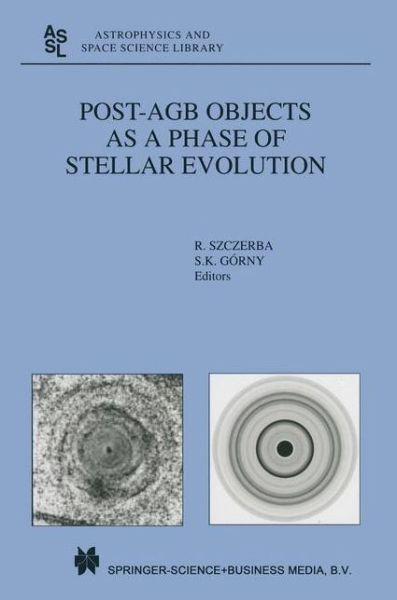
Powiedz znajomym o tym przedmiocie:
Post-AGB Objects as a Phase of Stellar Evolution - Astrophysics and Space Science Library 2001 edition
R. Szczerba
Post-AGB Objects as a Phase of Stellar Evolution - Astrophysics and Space Science Library 2001 edition
R. Szczerba
Proceedings of the Torun Workshop held July 5-7, 2000
Marc Notes: Includes bibliographical references and index. Table of Contents: Preface. Acknowledgements. Organizing Committees. List of Participants. Conference Photo. Introductory Review. Photo-planetary Nebulae as a Phase of Stellar Evolution; S. Kwok. Part I: Surveys and Observational Data. Observational Database and Statistical Properties of Proto-planetary Nebulae; R. Szczerba, et al. Optical Survey of Post-AGB Candidates; A. Manchado, et al. Hot Post-AGB Stars; M. Parthasarathy, et al. Properties of Post-AGB Stars with IRAS Colors Typical of Planetary Nebulae; G. C. Van de Steene, et al. BV RIJ H K Photometry of Post-AGB Candidates: Evolution of Post-AGB Central Stars; T. Fujii, et al. Near IR Observations of the Arecibo Sample of OH/IR Stars; F. Jimenez-Esteban, et al. HST Imaging of Proto-planetary Nebulae and Very Young Planetary Nebulae - Towards a New Understanding of Their Formation; R. Sahai. Morphological Properties of PPNs: Mid-IR and HST Imaging Surveys; T. Ueta, M. Meixner. MSC Sources in the LMC: Dust enshrouded AGB Stars and Post-AGB Stars; P. R. wood, M. Cohen. Post-AGB Stars in Globular Clusters and Galactic Halos; H. E. Bond, D. R. Alves. Part II: Stellar Evolution and Winds. The Evolution of AGB Stars Towards Planetary Nebulae; D. Schonberger, M. Steffen. Mass Loss Characteristics of Dust Forming Long-Period Variable Stars; J. M. Winters, T. Le Bertre. Pulsations in Proto-Planetary Nebulae as seen From Light Curve Studies; B. J. Hrivnak, et al. Atmospheric Dynamics of Post-AGB Stars: New Results on the Nature of the Pulsation of HD 56126; A. Lebre, et al. Light Variability of Color Selected IRAS Sources: Variables in Late AGB and Early Post-AGB Phase; T. Fujii, et al. Circumstellar Arcs in AGB and Post-AGB Stars; S. Kwok, et al. Simulations ofQuasi-Periodic Shells in Dust Forming AGB Winds; Y. Simis, et al. Polarimetry and Direct Imaging of Detached Shells Around Carbon Stars; D. G. Delgado, H. Olofsson. Evolution of Thin Gas Shells Along the AGB and Beyond; M. Steffen, D. Schonberner. Modelling of the Observed Post-AGB Evolution; R. Tylenda, et al. The Effect of the Transition Times in the Formation of Planetary Nebulae; E. Villaver, et al. Are Microstructures in the Outer Shells of PNe Fossil Condensations of the AGB Wind? D. R. Goncalves, et al. The Infrared [ WC] Stars; A. A. Zijlstra. Analysis of 5 PN with [ WC 8-11] Nuclei; K. Gesicki, A. Acker. Masses of Central Stars of Planetary Nebulae; K. Gesicki, A. A. Zijlstra. Part III: Binarity and Onset of Asymmetrical Structures. AGB Evolution in Binary Systems; A. Frankowski. Planets and Axisymmetric Mass Loss; N. Soker. Bipolar Outflows from OH/IR Stars; A. A. Zijlstra. The Shape and Shaping of Proto-Planetary Nebulae; B. J. Hrivnak, et al. SPH Models of Proto-Planetary Nebulae; A. J. Gawryszczak, et al. Dynamics of the Collimated Outflows of the PPN Hen 3-1475; A. Riera, et al. Strong Asymmetries in the Neutral Envelope of Mira; E. Josselin, et al. Mass Loss Geometry in Symbiotic Binaries; R. L. M. Corradi. Circumstellar Environment of RX Puppis; J. Mikolajewska, et al. The Sudden Loss of 0.01 M⊙ from the VV Cep's Primary as a Characteristic of AGB Evolution in the Binaries; D. Graczyk, M. Mikolajewski. Part IV: Evolution, Spectroscopy and Chemical Composition of Central Stars. AGB and Post-AGB Evolution: Structural and Chemical Changes; T. Blocker, et al. Stellar Evolution and Nucleosynthesis of Post-AGB Stars;"Publisher Marketing: The term proto-planetary nebulae (PPNe) in the context of the late stages of stellar evolution was created only slightly more than 20 years ago to express the belief that in the near future these objects will become planetary nebulae (PNe). The first proto-planetary nebulae (called also post-Asymptotic Giant Branch, or shortly post-AGB objects) AFGL 2688 and AFGL 618 were discovered in mid seventies in course of the Air Force Sky Survey. Investigation of this phase of stellar evolution developed very rapidly in 1980's after the IRAS mission when it became clear that proto-planetary nebulae emit a significant part of their energy in the mid-and far-infrared. Hundreds of new candidates have been proposed but the recognition of the real proto-planetary nebulae is not a simple task and needs a substantial effort to exclude cases that represent different evolutionary stages. High resolution spectroscopy of stellar atmospheres is of much importance in this respect. Surprisingly, only a small group of central stars, the so called 21 11m emitters, show chemical signatures of the 3 rd dredge up process. Very recently, a more detailed studies of mid-infrared spectra from the Infrared Space Observatory (ISO) allow for a better understanding of chemical composition and evolution of circumstellar material around these stars. A new impetus in the field of proto-planetary nebulae research was started in the 1990's with high spatial resolution imaging in mid-infrared and optical wavelength ranges."
| Media | Książki Hardcover Book (Książka z twardym grzbietem i okładką) |
| Wydane | 31 sierpnia 2001 |
| ISBN13 | 9780792371458 |
| Wydawcy | Springer |
| Strony | 448 |
| Wymiary | 155 × 235 × 26 mm · 839 g |
| Redaktor | Gorny, S.K. |
| Redaktor | Szczerba, R. |
Zobacz wszystko od R. Szczerba ( np. Hardcover Book )

